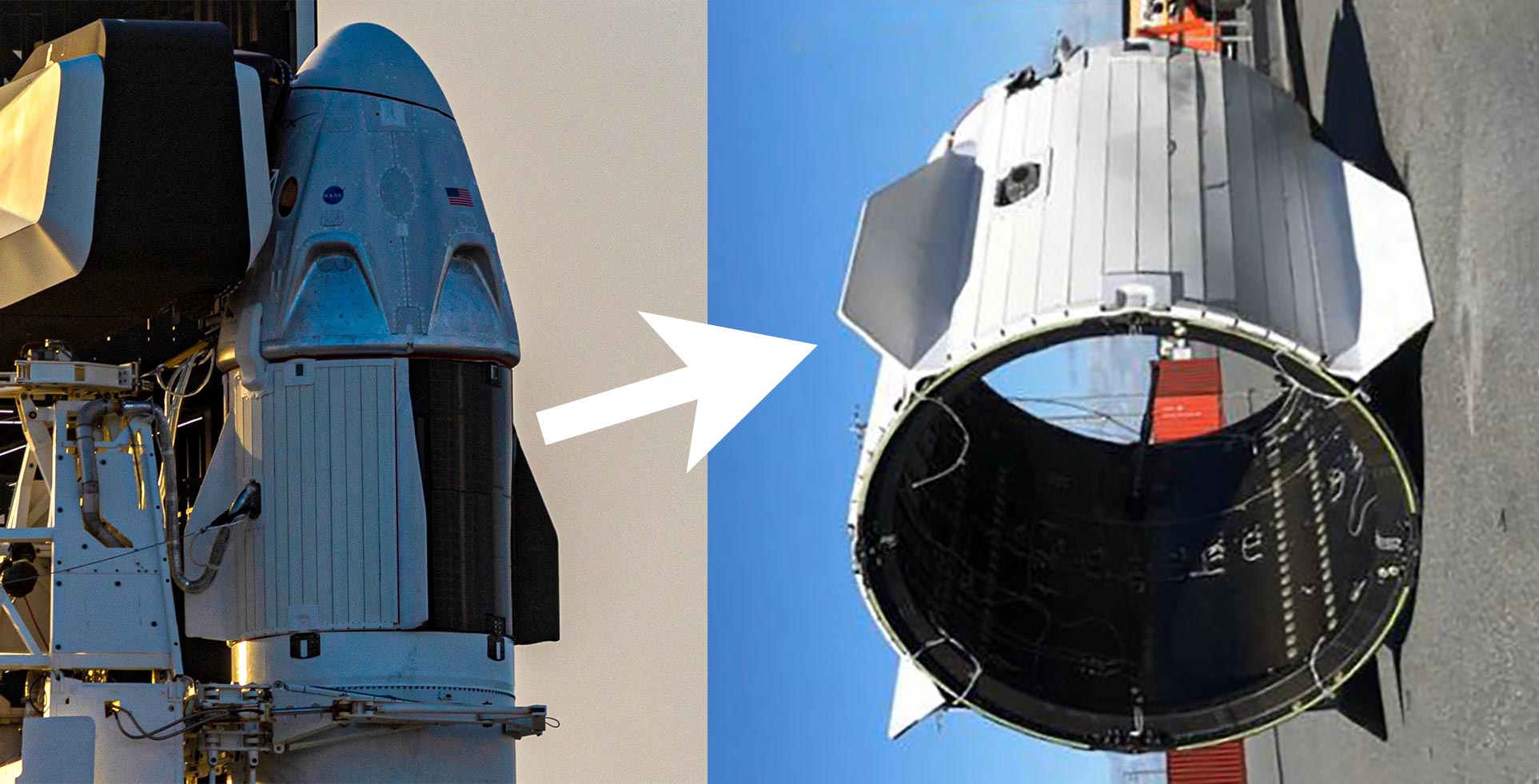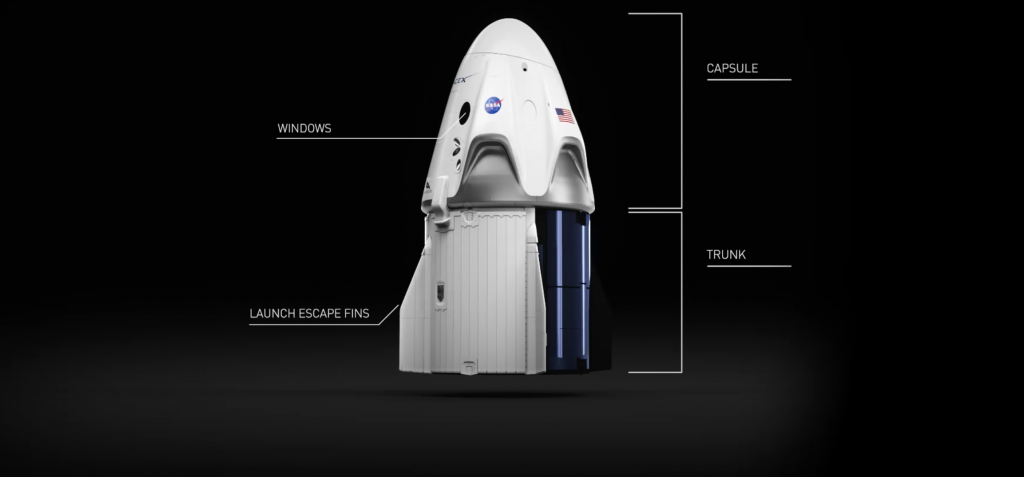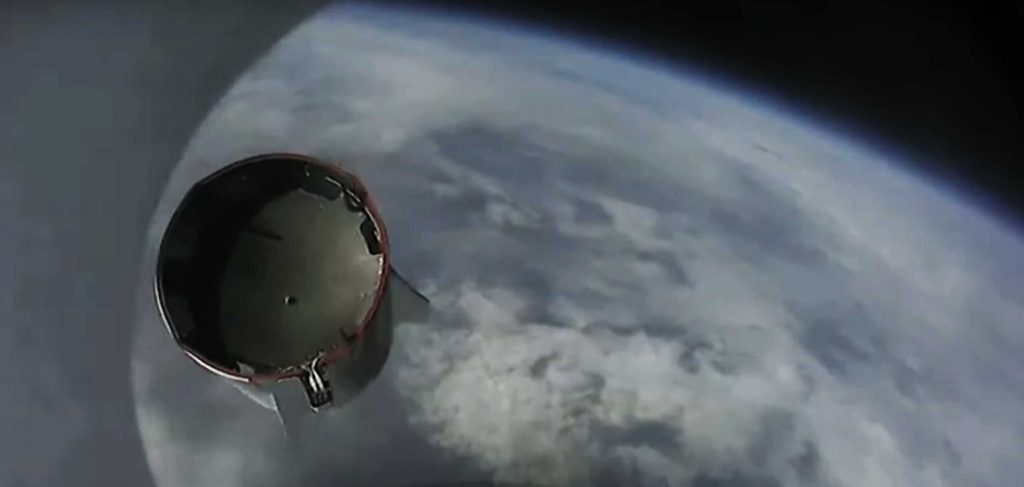

News
SpaceX surprises after recovering spacecraft 'trunk' in one piece
In a surprise twist, SpaceX has recovered an expendable ‘trunk’ that launched with Crew Dragon on its January 19th In-Flight Abort (IFA) test, in which the spacecraft successfully escaped from an exploding Falcon 9 rocket.
While recovering pieces of Dragon’s disposable trunk would not have been shocking, SpaceX has returned this particular Crew Dragon trunk to shore in a condition that can only be described as unscathed. The surprise came first on the evening of January 19th, when two separate SpaceX ships returned to Port Canaveral — first and foremost bringing Crew Dragon capsule C205 back to dry land for inspection and possible reuse. However, a separate ship – GO Navigator – followed the ship carrying Crew Dragon not long after, revealing a shockingly intact Dragon trunk on its deck.
At 10:30 am EST (15:30 UTC) on January 19th, Falcon 9 booster B1046, an expendable upper stage, and the newest Crew Dragon spacecraft lifted off from Kennedy Space Center (KSC) Launch Complex 39A (Pad 39A) on the spacecraft’s second-ever integrated launch. Designed to push Crew Dragon’s abort systems to their limits, the spacecraft ignited its SuperDraco thrusters around 85 seconds after liftoff, soaring away from a supersonic Falcon 9 and triggering the rocket’s catastrophic (but expected) explosion around 10 seconds later.
A bit like pushing against a wall, Crew Dragon had to fight uphill against a continuous supersonic blast of air to escape the Falcon 9 rocket that launched it, likely adding tens of thousands of pounds (several dozen metric tons) of additional pressure spread out over the top of the capsule. The spacecraft and its detachable trunk section – carrying a solar array, radiators, and four fins – appeared to survive the experience without issue.


The capsule’s SuperDraco engines shut off after about 10 seconds, leaving the integrated spacecraft to coast to an apogee of ~40 km (25 mi), where it finally detached its trunk (pictured above). Designed to be disposable, Crew Dragon features a trunk functionally similar to the one SpaceX has flown almost 20 times on Cargo Dragon (Dragon 1) missions. Crew Dragon’s trunk looks quite a bit different, stretching taller and featuring an interesting conformal solar array (vs. Dragon 1’s deployable panels), as well as radiators (white rectangular panels) the spacecraft needs to maintain thermal equilibrium while in space.
Nominally, Crew Dragon and Cargo Dragon launch on Falcon 9, reach orbit, and go about their business of delivering astronauts and cargo to and from the International Space Station (ISS). After completing their given mission, the trunk section is eventually detached an hour or two before one last reentry burn, eventually returning the spacecraft to Earth. The trunk is thus left in low Earth orbit (LEO), eventually reentering on its own days, weeks, or months later and vaporizing into plasma before it hits Earth’s surface.
While it’s thus surprising that Crew Dragon C205’s trunk section – built primarily out of carbon composites like Falcon 9’s payload fairing and interstage – survived its In-Flight Abort mission more or less intact, the unexpected recovery sadly doesn’t mean that SpaceX has any plans to try to routinely recover or reuse the hardware. If Dragon trunks detached well before orbit, SpaceX might reconsider, but that would defeat their purpose of providing Dragons with power and thermal management while in orbit.
Surviving a terminal-velocity ocean splashdown is certainly no mean feat, but surviving an orbital-velocity atmospheric reentry is magnitudes more challenging, although SpaceX is certainly cognizant of the trade-off. Starship, for example, is expected to include thermal management and power generation systems as an integral part of the (nominally) fully-reusable spaceship and upper stage. At the scale of Crew Dragon, it’s just hard to rationalize doubling or tripling the mass of the spacecraft’s trunk just to tack on a complex recovery system.
All told, both NASA and SpaceX have since indicated that preliminary telemetry from Crew Dragon’s In-Flight Abort test paints an extremely positive picture and effectively confirmed that the test was a total success. With a little luck, it’s safe to say that Crew Dragon will be sacrificing a trunk section in orbit before returning NASA astronauts to Earth just a few months from now.
Check out Teslarati’s Marketplace! We offer Tesla accessories, including for the Tesla Cybertruck and Tesla Model 3.

Elon Musk
Elon Musk confirms xAI’s purchase of five 380 MW natural gas turbines
The deal, which was confirmed by Musk on X, highlights xAI’s effort to aggressively scale its operations.

xAI, Elon Musk’s artificial intelligence startup, has purchased five additional 380 MW natural gas turbines from South Korea’s Doosan Enerbility to power its growing supercomputer clusters.
The deal, which was confirmed by Musk on X, highlights xAI’s effort to aggressively scale its operations.
xAI’s turbine deal details
News of xAI’s new turbines was shared on social media platform X, with user @SemiAnalysis_ stating that the turbines were produced by South Korea’s Doosan Enerbility. As noted in an Asian Business Daily report, Doosan Enerbility announced last October that it signed a contract to supply two 380 MW gas turbines for a major U.S. tech company. Doosan later noted in December that it secured an order for three more 380 MW gas turbines.
As per the X user, the gas turbines would power an additional 600,000+ GB200 NVL72 equivalent size cluster. This should make xAI’s facilities among the largest in the world. In a reply, Elon Musk confirmed that xAI did purchase the turbines. “True,” Musk wrote in a post on X.
xAI’s ambitions
Recent reports have indicated that xAI closed an upsized $20 billion Series E funding round, exceeding the initial $15 billion target to fuel rapid infrastructure scaling and AI product development. The funding, as per the AI startup, “will accelerate our world-leading infrastructure buildout, enable the rapid development and deployment of transformative AI products.”
The company also teased the rollout of its upcoming frontier AI model. “Looking ahead, Grok 5 is currently in training, and we are focused on launching innovative new consumer and enterprise products that harness the power of Grok, Colossus, and 𝕏 to transform how we live, work, and play,” xAI wrote in a post on its website.
Elon Musk
Elon Musk’s xAI closes upsized $20B Series E funding round
xAI announced the investment round in a post on its official website.

xAI has closed an upsized $20 billion Series E funding round, exceeding the initial $15 billion target to fuel rapid infrastructure scaling and AI product development.
xAI announced the investment round in a post on its official website.
A $20 billion Series E round
As noted by the artificial intelligence startup in its post, the Series E funding round attracted a diverse group of investors, including Valor Equity Partners, Stepstone Group, Fidelity Management & Research Company, Qatar Investment Authority, MGX, and Baron Capital Group, among others.
Strategic partners NVIDIA and Cisco Investments also continued support for building the world’s largest GPU clusters.
As xAI stated, “This financing will accelerate our world-leading infrastructure buildout, enable the rapid development and deployment of transformative AI products reaching billions of users, and fuel groundbreaking research advancing xAI’s core mission: Understanding the Universe.”
xAI’s core mission
Th Series E funding builds on xAI’s previous rounds, powering Grok advancements and massive compute expansions like the Memphis supercluster. The upsized demand reflects growing recognition of xAI’s potential in frontier AI.
xAI also highlighted several of its breakthroughs in 2025, from the buildout of Colossus I and II, which ended with over 1 million H100 GPU equivalents, and the rollout of the Grok 4 Series, Grok Voice, and Grok Imagine, among others. The company also confirmed that work is already underway to train the flagship large language model’s next iteration, Grok 5.
“Looking ahead, Grok 5 is currently in training, and we are focused on launching innovative new consumer and enterprise products that harness the power of Grok, Colossus, and 𝕏 to transform how we live, work, and play,” xAI wrote.
Investor's Corner
Tesla gets price target bump, citing growing lead in self-driving

Tesla (NASDAQ: TSLA) stock received a price target update from Pierre Ferragu of Wall Street firm New Street Research, citing the company’s growing lead in self-driving and autonomy.
On Tuesday, Ferragu bumped his price target from $520 to $600, stating that the consensus from the Consumer Electronics Show in Las Vegas was that Tesla’s lead in autonomy has been sustained, is growing, and sits at a multiple-year lead over its competitors.
CES 2026 validates Tesla’s FSD strategy, but there’s a big lag for rivals: analyst
“The signal from Vegas is loud and clear,” the analyst writes. “The industry isn’t catching up to Tesla; it is actively validating Tesla’s strategy…just with a 12-year lag.”
The note shows that the company’s prowess in vehicle autonomy is being solidified by lagging competitors that claim to have the best method. The only problem is that Tesla’s Vision-based approach, which it adopted back in 2022 with the Model 3 and Model Y initially, has been proven to be more effective than competitors’ approach, which utilizes other technology, such as LiDAR and sensors.
Currently, Tesla shares are sitting at around $433, as the company’s stock price closed at $432.96 on Tuesday afternoon.
Ferragu’s consensus on Tesla shares echoes that of other Wall Street analysts who are bullish on the company’s stock and position within the AI, autonomy, and robotics sector.
Dan Ives of Wedbush wrote in a note in mid-December that he anticipates Tesla having a massive 2026, and could reach a $3 trillion valuation this year, especially with the “AI chapter” taking hold of the narrative at the company.
Ives also said that the big step in the right direction for Tesla will be initiating production of the Cybercab, as well as expanding on the Robotaxi program through the next 12 months:
“…as full-scale volume production begins with the autonomous and robotics roadmap…The company has started to test the all-important Cybercab in Austin over the past few weeks, which is an incremental step towards launching in 2026 with important volume production of Cybercabs starting in April/May, which remains the golden goose in unlocking TSLA’s AI valuation.”
Tesla analyst breaks down delivery report: ‘A step in the right direction’
Tesla has transitioned from an automaker to a full-fledged AI company, and its Robotaxi and Cybercab programs, fueled by the Full Self-Driving suite, are leading the charge moving forward. In 2026, there are major goals the company has outlined. The first is removing Safety Drivers from vehicles in Austin, Texas, one of the areas where it operates a ride-hailing service within the U.S.
Ultimately, Tesla will aim to launch a Level 5 autonomy suite to the public in the coming years.








